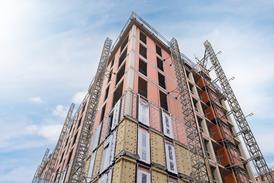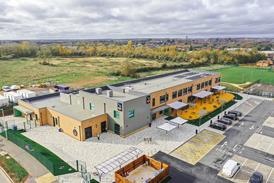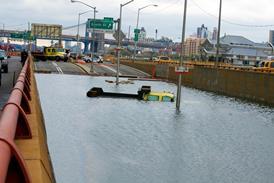Sixteen sustainable low-energy houses and flats were constructed in Glasgow for £60,900 each. This low capital price was achieved despite building in sophisticated environmental features that will significantly cut whole-life costs.
<b>At-a-glance guide</b>
<b>Shettleston Sustainable Housing</b>
<b>Project</b>
A demonstration sustainable, renewable-energy housing project of 16 houses and flats
<b>Client</b>
Shettleston Housing Association, Glasgow
<b>Location</b>
Glenalmond Street, Shettleston, Glasgow
<b>Construction budget</b>
£974,400 (including VAT and fees) 16 dwellings at £60,900 each
<b>Sustainable features</b>
A combined solar and geothermal heat system and high insulation should reduce annual heating and hot water costs to about £30 and £60 a year respectively for a typical flat. Other sustainable features include recycled building materials, a recycled water system and car-free layout.
<b>Cost and procurement constraints</B>
Cost limits, as for conventional housing, were set by Scottish Homes as part of a design brief.
<b>The contract</b>
The design-and-build contract brought the contractor on board in the early design stages, with the architect and engineer novated to it after contract agreement. The contract was the Standard Form of Building Contract with Contractor’s Design, 1981 Edition; Scottish Supplement with Contractors Design (July 1997 Revision)
<b>Design</b>
The project was the result of a Housing Association Grant competition organised by Scottish Homes to encourage ideas in sustainable housing. The main aim of the brief was to reduce tenants’ running costs while at the same time ensuring that the construction of the houses and selection of materials takes into account the full implications of their energy life-cycle.
The narrow site was tight; bordered by a church and hall to the north, a bowling green to the east, and more housing to the south. The development comprises a terrace of two-storey houses running east to west, so they get as much natural light as possible; and two linked three-storey blocks of flats, mostly south- and west-facing, making as much use of the site as possible. All the houses have lobby or utility spaces to front and rear to reduce heat loss. The flats are accessed from a large glazed atrium – a communal suntrap for the flats.
The scheme is “car-free”, providing only disabled parking and four on-street parking spaces, but allowing for service access. The semi-private front garden is a pleasant environment and a safe place for children to play. Bearing disabilities in mind, the dwellings are as barrier-free as possible, and have ground-floor toilets in the terraced houses and straight stairs that can accommodate stair lifts. One of the ground-floor flats is designed for wheelchair circulation and has its own car parking bay.
<b>Sustainable features</b>
The design made use of geothermal energy combined with supplementary solar panels. House production ideas were selected for their energy efficiency and internal air quality; the materials for their capacity to use as little embodied energy as possible.
The house designs themselves allowed internal flexibility with barrier-free standards to the layout, allowing for the secondary uses of loft spaces. Finally, carefully selected plants and flowers and the absence of cars make it a more pleasant environment, and a safer one – especially for children.
The main sustainable features are:
- Kit construction using timber I-beams and 160 mm warmcell insulation; cladding with a mixture of larch, Blueclad boarding with Sto render, and a locally made brick.
- Minimal use of treated timbers; softwood flooring instead of chipboard; low VOC (volatile organic compounds) paints to improve air quality
- Low-odour paints and stains that are resin-oil-based with no toxic emissions from biocides
- Recycled materials, including metal fencing, paving slabs, stone setts, brickwork, two bathroom suites, and selected flooring
- Recycled water: waste water from the nearby mine is fed into a storage tank and used for flushing toilets. Excess water is returned to the mine.
Finding an alternative to PVCu gutters and downpipes proved impossible within budget. HDPE pipe was considered, but needed a special jointing system, making it more difficult to dismantle in the future.
Treating timber with boron, the least harmful preservative, was considered, but the timber would have had to have been transported to Inverness and back. Instead, a water-based aqua-vac treatment was used for the timbers that required treatment, and was kept to a minimum.
<b>Energy strategy</b>
The calculated standard assessment procedure rating is a maximum of 100, thanks to a package of low-energy measures. The annual heating costs for a typical flat have been calculated as being about £30 a year, with hot water another £60. Certain energy-saving ideas were employed:
- <b> High thermal</b>
- insulation Because the houses are well insulated (U-value of 0.2 Wm2°C for walls), it was feasible to use low-temperature water heating
- <b> Geothermal heating</b>
- A disused coal mine nearby was tapped for heat. The 100 m deep mine is flooded with water at a constant 12°C
- <b> Hot water storage</b>
- The water from the mines is passed through a heat pump and stored in a massive two-storey high, 10 000 litre thermal storage tank built into the block of flats. The tank keeps the water at about 55°C with heat pumps that work at an off-peak tariff
- <b> Solar panels</b>
- 36 m2 of solar water panels provide a substantial daytime heat boost to the thermal tank. The warmed water provides sufficient heating as well as heating individual hot water cylinders in each house to about 40°C
- <b> Solar-heated ventilation</b>
- Four houses have a pressurised air system that makes use of daytime pre-heated air entering the space between tiles and sarking: there is a natural heat gain under tiled roofs of up to 10°C. This preheated air is fed by a fan into the hallway, where it circulates around each room.
- <b>Cost commentary</B>
- The cost allowances comparable with conventional housing were set by the main funding body, Scottish Homes, was set at £60 900 a unit inclusive of fees, site acquisition and VAT. In addition, Forward Scotland contributed a total of £14 000 towards the costs of the solar energy and water recycling systems.
- With no parking spaces requiring hard landscaping works, the money saved could be spent enhancing the dwellings.
- The capital costs of the geothermal/solar heating installations, at £3385 a unit, are significantly higher than traditional gas-fired domestic systems. However, this cost will be offset in the long term; it requires little maintenance and has low running costs.
- The original floating timber floor over a concrete slab had to be changed to a concrete screed over 75 mm of polystyrene insulation, resulting in a saving of £3000 a dwelling. Tenants and developer collaborated over the interior decoration.
- Four of the houses were sold under a shared ownership scheme and the rest are available for rent.
- <b>Procurement</b>
- The main contractor was brought on board as part of the team at the outset. Ideas to ease the method of construction were incorporated into the design, although more prefabrication was envisaged initially. However, there was insufficient repetition to benefit from this development. Although the client employed the consultants up to the detailed design stage, the architect and engineer, were novated to the main contractor once the contract was let.
- <b>Specification </b>
- <b>Demolitions</b>
- Old laundry demolished and several thousand bricks retained and cleaned to be used as butts in rear perimeter wall; setts and paving slabs stored and re-used. Minimal levelling of site.
- <b>Substructure</b>
- Concrete raft with 75 mm polystyrene insulation and concrete screed.
- <b>External walls</b>
- 160 mm TJM I-beams with 12 mm Panelvent sheathing. Wet-blown cellulose insulation fill with BSK 410 membrane; service void and plasterboard finish. External cladding at low levels in Ibstock Kilcreggan Red Multi. Flats clad in Blueclad and finished in Sto render; houses clad in overlapping larch boarding.
- <b>Separating floors </b>
- I-beam flooring joists at 600 crs, OSB working deck, floating floor construction with gyproc plank and 20 mm tongue-and-groove softwood flooring. Acoustic quilt between joists and ceiling of 30 mm plasterboard.
- <b>Roof </b>
- Interlam ridge-beam spanning to cross walls; rafters from 300 mm TJM I-beams, plasterboard sheeted on inside; Panelvent sarking and void fully filled with dry cellulose insulation. Larch battens and counterbattens; concrete tilework. Attic space largely floored; open attic deck in upstairs flats. Roofs to three-storey flats angled to optimum angle for solar panels, with access deck for maintenance.
- <b>Windows and external doors </b>
- Softwood windows double glazed with low-emissivity glass. Atrium glazing uses Vitral framing. Douglas fir external doors with double glazing, three-point locking. Internal walls and partitions 89 × 40 sw and 70 × 40 sw studs; plasterboard finish. Some internal toughened glass glazed walls
- <b>Internal doors </b>
- Maple-veneered flush doors; aluminium lever furniture. Also softwood glazed doors, foldback and sliding style.
- <b>Fixtures and fittings </b>
- Low formaldehyde kitchen units built in wardrobes in all bedrooms; Barrhead sanitaryware. Some flats fitted with showers and adapted for disabled access; wheelchair-accessible toilet in all three-bedroom houses.
- <b>Atrium </b>
- Single-glazed sunspace with opening vents; internal plant beds; stairs and decking in steel frame with concrete infill and rubber floor finish. Perforated metal balustrade folds down to form maintenance deck for glazing.
- <b>Services </b>
- Combined geothermal/solar system with communal thermal storage tank; wet radiator system; individual hot-water cylinders. Passive stack ventilation. Solar pre-heat ventilation to three-bedroom houses. Mine water recycling for toilet cisterns. Entryphone system for flats; communal television and satellite system.
- <b>External works</b>
- Car-free scheme with tarmac service route. Bollard and standard lighting plus rear bulkhead lighting. Deep beech hedging at front; communal space and private gardens to rear; recycled metal railings, post and wire division fence and planting; individual bin stores
Credits
client
Shettleston Housing Association
architect
John Gilbert Architects
quantity surveyor
Armour Construction Consultants
structural engineer
Montgomery Smith
services engineer
enconsult
planning supervisor
HAPM
contractor
Robinson & Davidson























